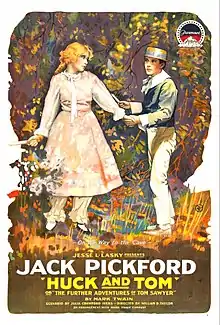Huck and Tom
Huck and Tom is a surviving American comedy-drama film directed by William Desmond Taylor and released in 1918. The scenario by Julia Crawford Ivers is derived from Mark Twain's novels The Adventures of Tom Sawyer (1876) and The Adventures Of Huckleberry Finn (1884). Robert Gordon and Jack Pickford reprise the title roles from the 1917 version of Tom Sawyer, a successful adaptation that was also directed by Taylor.[1][2]
| Huck and Tom | |
|---|---|
 Film poster | |
| Directed by | William Desmond Taylor |
| Written by | Mark Twain (stories) Julia Crawford Ivers |
| Produced by | Jesse L. Lasky |
| Starring | Jack Pickford Robert Gordon George Hackathorne Edythe Chapman Frank Lanning Clara Horton Helen Gilmore Antrim Short Jane Keckley |
| Cinematography | Homer Scott |
| Distributed by | Famous Players–Lasky Co. Paramount Pictures |
Release date | May 13, 1918 |
Running time | 5 reels |
| Country | United States |
| Language | Silent (English intertitles) |
Plot
As described in a film magazine,[3] while in a graveyard trying an old remedy to get rid of their warts, Tom (Pickford) and Huck (Gordon) witness a murder. At the trial their repetition of the story clears Muff Potter (Bates), an innocent suspect and victim of Injun Joe's (Lanning) plot. Injun Joe escapes to the Painted Cave, where the next day Tom and Becky (Horton) become lost. After a four-day search the missing ones come home and the entrance to the Painted Cave is sealed. Tom tells Judge Thatcher (Burton) that Injun Joe is hiding there. The entrance to the cave is opened and the dead body of the murderer is brought out. Tom and Huck become the possessors of a treasure they found, and with this fortune they plan on becoming great and fierce robbers.
Cast
- Jack Pickford as Tom Sawyer
- Robert Gordon as Huck Finn
- George Hackathorne as Sid Sawyer
- Alice Marvin as Mary Sawyer
- Edythe Chapman as Aunt Polly
- Frank Lanning as Injun Joe
- Clara Horton as Becky Thatcher
- Tom Bates as Muff Potter
- Helen Gilmore as Widow Douglas
- Antrim Short as Joe Harper
- Jane Keckley as Mrs. Thatcher
- John Burton as Judge Thatcher
Reception
Upon its March 1918 release, Huck and Tom received lukewarm reviews. Variety called it "acceptable" and Photoplay described it as "not so fascinating, being an unbelievable mixture of boyish fancy and Brady melodrama."[4]
Like many American films of the time, Huck and Tom was subject to cuts by city and state film censorship boards. For example, the Chicago Board of Censors required cuts of, in Reel 1, the stabbing of a man in the back, robbing the dead man, in Reel 2, a vision of the stabbing of the man, and, in Reel 4, two scenes of Injun Joe prying open a window.[5]
Preservation status
This film is preserved at Archives du Film du CNC, Bois d'Arcy Archive.[6]
References
- Progressive Silent Film List: Huck and Tom at silentera.com
- The AFI Catalog of Feature Films: Huck and Tom
- "Reviews: Huck and Tom". Exhibitors Herald. New York City: Exhibitors Herald Company. 6 (13): 24. March 23, 1918.
- The Silent Movie Multiplex Archived 2011-06-30 at the Wayback Machine
- "Official Cut-Outs by the Chicago Board of Censors". Exhibitors Herald. 6 (13): 29. March 23, 1918.
- The Library ofCongress American Silent Feature Film Survival Catalog: Huck and Tom
External links
- Huck and Tom at IMDb
- synopsis at AllMovie